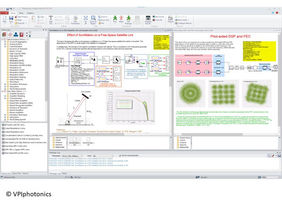VPIphotonics Design Suite – Version 11.3

VPIphotonics Design Suite Version 11.3 provides access to professional application-specific simulation tools and pluggable toolkits. They offer flexible usability, design process, and data analysis capabilities.
Version 11.3 advances the simulation and design flow for many applications: data-aided DSP, FEC, FSO communications, Raman pump optimization, grating couplers, SOAs, multimode coupling, and more.
Our software solutions have been proven by commercial companies and educational institutions who have utilized them to win and successfully execute many research an design projects. With the improved capabilities provided in Version 11.3, our design suite is set to deliver the same outstanding results in the future.
Short list of key features in Version 11.3
Sorting of DSP algorithms – Improved sorting order of built-in
DSP algorithms, with updated categories for easy access and
implementation
• Pilot Symbols for DSP – New modules add/remove arbitrary
sequences of pilot symbols for pilot-aided DSP algorithms
• Pilot-aided DSP algorithms – New algorithms for frequency
offset compensation and maximum likelihood based carrier
phase recovery that exploit pilot symbols for single- and
multicarrier signals
• RS-based FEC – Enhanced FEC encoder/decoder to support
Reed-Solomon codes of user-definable codeword lengths
• PAM4 analysis – Direct calculation and display of signal metrics
for PAM4 signals in the Analyzer
• FSO channel – Enhanced model to simulate Gaussian beam
propagation through a turbulent atmospheric channel in a
satellite uplink and downlink
• PPM encoding – New M-ary pulse position modulator with any
number of bits per symbol using Gaussian-shaped pulses and
corresponding demodulator
• Raman pump optimizer – Enhanced module to support multiple
optimization wavelength ranges and pumps within them
• Interface to ZOS – New module interfacing to Zemax OpticStudio
to calculate the light coupling between two multimode
waveguides via an optical imaging system
• S-Matrix without phase – Extended PIC Elements modules to
support passive device modeling with absent or wrapped phase
information in device S-Matrix files
• Grating Coupler – New passive grating coupler with a measured
and behavioral model supporting various spectral transfer
functions
• SOA – Measured SOA with length independent model definition
and support of a chain of subsections to accurately calculate
device properties
• Parameter browser – New dialog to overview parameter usage,
search for a parameter, change parameter values in multiple
schematics at once
• Copy traces in Analyzers – Enhanced support to copy signals
between different Analyzer frames and Analyzer windows using
different axis units
• Python Debugging – New approach to debugging Python
cosimulation, simulation scripts, or initialization scripts based
on Microsoft Visual Studio Code
• Resource Replacement – Greatly simplified update of obsolete
module versions with redesigned Resource Replacement Wizard
Version 11.3 provides access to more than 900 ready-to-run
simulation setups. We added new and improved demo examples to
illustrate the application of the new features and modules.
Design Example – 800G FR-4 WDM for Ethernet Applications
This simulation setup demonstrates the transmission of 4*200G
FR-4 WDM channels with 112.5 Gbaud as specified by the 800G
Pluggable MSA technical specification [1]. Four wavelengthseparated
transmitters in the O-band emit a PAM4 signal each. The
outer FEC encoder utilizes Reed-Solomon RS(544,514) coding.
The setup shows the impact of bandwidth limitations on the system
performance and the capability of the RS-based FEC. BER pre-FEC
and post-FEC are used to evaluate the system performance.
